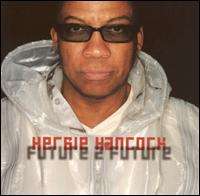Future 2 Future
| Future 2 Future | ||||
|---|---|---|---|---|
 | ||||
| Studio album by Herbie Hancock | ||||
| Released | 2001 | |||
| Recorded | 2001 | |||
| Genre | Jazz, electronica, jazz fusion | |||
| Label | Transparent, Columbia (Japan) | |||
| Herbie Hancock chronology | ||||
| ||||
| Professional ratings | |
|---|---|
| Review scores | |
| Source | Rating |
| Allmusic | |
Future 2 Future is the forty-third album by Herbie Hancock. Hancock reunited with bass player Bill Laswell (who worked on the influential early 1980s albums Future Shock, Sound-System and Perfect Machine) and the two of them tried to recapture the success of the three previous albums that fuse jazz with cutting-edge electronic music.
In yet another innovative stylistic move, Herbie reunited with Bill Laswell in the creation of a 21st Century collaboration with some of the young hip-hop and techno artists who have drawn on his massive influence to create their own music of the future. The album was released in spring, 2001, and is entitled FUTURE2FUTURE.[2]
This group of artists (minus Tony Williams, due to his death four years prior) would go on tour, and produce a live concert that would eventually go on DVD (which features live versions of his songs "Rockit" and "Chameleon").
Content
Future2Future is the only album Hancock released on Transparent Music, a label he created in the late 90's with Chuck Mitchell (one time president of Verve Records) and David Passick (Hancock's manager). The main collaborative source is in Bill Laswell, who Hancock had worked with many times before, including the incredibly successful Future Shock (most known for the club hit "Rockit"). Future2Future is very different from previous efforts due to its attempt to delve further into electronica. Hancock keeps most of his playing relatively conservative, holding to chords and sweeps while Laswell has short grooves on the bass guitar. The more intricate sounds on each track are in the drum beats (whether played on a kit or electronically generated) and the use of turntables.
Tony Williams, a drummer Hancock had worked with multiple times throughout his career, is sampled on track 6 under softly spoken poetry by Dana Bryant.
An album of remixes was released to make some of the songs more pop accessible. After releasing the album the band took the tracks on tour, and a film of the tour's stop at the Knitting Factory in Hollywood was made.
Critical reception
- AllMusic gave a positive 3/5 review, stating that while the album fails to live up to expectations, it is "an enjoyable exercise in watching one of the greats in jazz music redefine himself with the times once again." [3]
- Grove Dictionary of Music gave 3/5.[4]
- JazzTimes gave no numeric rating, stating that the album lacks focus and the performances are uninspired. The best tracks are the last four instrumentals ("Ionosphere", "Kebero Part II", "Alphabeta", "Virtual Hornets").[5]
Track listing
">" indicates a segue directly into the next track.
- "Kebero Part I" > - 3:10
- "Wisdom" > - 0:33
- "The Essence" > - 4:54
- "This Is Rob Swift" - 6:55
- "Black Gravity" - 5:29
- "Tony Williams" - 6:09
- "Be Still" - 5:12
- "Ionosphere" > - 3:59
- "Kebero Part II" - 4:47
- "Alphabeta" - 5:29
- "Virtual Hornets" - 8:51
Personnel
- Herbie Hancock – keyboards
- Wayne Shorter – tenor saxophone, soprano saxophone
- Bill Laswell – bass guitar
- Charnett Moffett – double bass
- Jack DeJohnette – drums (4, 8, 9, 10)
- Karsh Kale – drums (3, 8)
- Tony Williams – drums (6)
Guest musicians
- A Guy Called Gerald – programming, beats (5)
- Carl Craig – programming, beats (1, 9)
- Rob Swift – turntables, programming (4)
- Dana Bryant – vocals, words (6)
- Gigi – vocals (1, 9)
- Chaka Khan – vocals (3)
- Imani Uzuri – vocals (7)
- Elenni Davis – spoken vocals (2)
References
- ↑ Theakston, Rob (2011). "Future 2 Future - Herbie Hancock | AllMusic". allmusic.com. Retrieved 26 June 2011.
Transparent Music
- ↑ Herbie Hancock Official website: Biography Archived 2008-08-27 at the Wayback Machine.
- ↑ All Music Guide - Herbie Hancock "Future 2 Future" review
- ↑ Oxford Music Online
- ↑ Porter, Christopher (1 January 2002). "Herbie Hancock: Future 2 Future - JazzTimes". JazzTimes. Retrieved 16 July 2018.